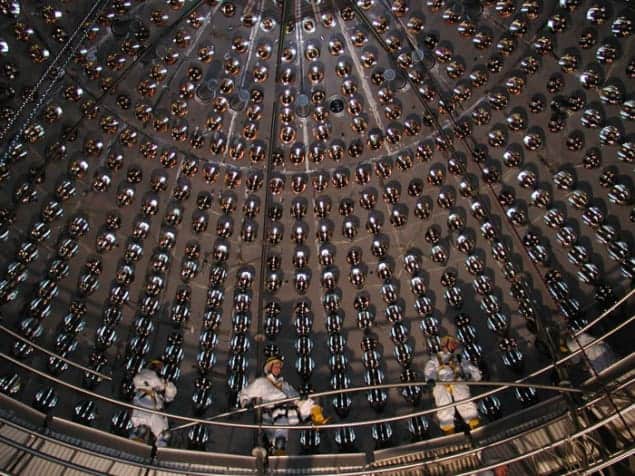
Neutrinos captured under a mountain in central Italy have provided the first direct evidence for a nuclear reaction involved in the conversion of hydrogen to helium inside the Sun. The observation was made by the Borexino collaboration, which next hopes to ensnare as-yet-unseen neutrinos from fusion reactions taking place in stars heavier than our own.
Most of the Sun’s heat is generated in fusion reactions that form what is known as the “proton–proton cycle”. This involves the fusion of two hydrogen nuclei (protons) to form heavy hydrogen, the fusion with a third hydrogen nucleus to form helium-3 and then, via various pathways, the creation of extremely stable helium-4.
Physicists can learn about this cycle by intercepting the chargeless, nearly massless particles known as neutrinos that are produced in many of the constituent reactions. In fact, by measuring the fluxes of these particles, they can learn not just about the structure and dynamics of the Sun, but also about the properties of neutrinos themselves. To date, however, most neutrino detectors have been sensitive to the highest energy solar neutrinos – those having energies of between about 5–18 MeV. However, the vast majority of solar neutrinos have energies below 5 MeV, and Borexino was built specifically to study these particles.
Detection is demanding
Detecting any kind of neutrino is difficult because the particles interact extremely weakly with all other kinds of matter. But capturing the low-energy neutrinos from the Sun is particularly demanding as natural radioactive processes here on Earth generate particles with energies up to about 3 MeV, which can therefore obscure the low-energy neutrino interactions. Like other neutrino experiments, Borexino is located deep underground to protect it from interference from cosmic rays, being housed in the laboratory of Italy’s National Institute of Nuclear Physics at Gran Sasso. And, like other experiments, it contains a large mass of detecting material, in this case about 280 tonnes of a liquid scintillator, which generates flashes of light when neutrinos scatter off electrons inside it. What sets the experiment apart, however, is the extreme purity of the materials used to create it, such as the scintillator itself and the stainless-steel sphere that holds the scintillator – with levels of radioactivity inside each one reduced by up to 10 or 11 orders of magnitude.
In data collected between 2007–2010, the Borexino collaboration, made up of physicists from Italy, the US, Germany, France and Russia, had already identified solar neutrinos from the conversion of beryllium-7 into lithium-7. Having a very well-defined energy of 0.86 MeV, these neutrinos were detected at a rate of about 50 a day for every 100 tonnes of scintillator. In the latest analysis, which uses data obtained since January 2008, the researchers observe even rarer events – the detection of solar neutrinos with a precise energy of 1.44 MeV that are generated by the fusion of two protons and an electron in “pep” reactions. Using a new data-analysis technique to mask interference from nuclei of carbon-11, which are produced by the few cosmic-ray particles that make it down to the experiment, the researchers found that, on average, pep neutrinos collide with 100 tonnes of detector material 3.1 times a day.
First direct evidence
According to Borexino spokesman Gianpaolo Bellini, this is the first direct evidence of pep reactions taking place in the Sun, and he says that the observed flux matches well with the predictions of astrophysicists’ “standard solar model”. But he points out that further data will be needed to fully exploit Borexino’s potential as a probe of neutrino “oscillations”. Results from many different experiments over several decades have revealed that neutrinos oscillate from one kind (electron, muon or tau) to another as they travel through space, but physicists would like to know exactly how the strength of these oscillations varies with neutrino energy. Other experiments have shown that theoretical predictions agree well with the data at higher energies, while Borexino’s beryllium-7 result shows that there is also a good fit at the lowest energies. But, says Bellini, more pep neutrinos will have to be detected in order to gather sufficient data at intermediate energies.
In fact, the Borexino researchers are currently overhauling their detector to reduce levels of radioactivity still further and then hope to start three more years of data-taking in March or April. These new data might also confirm the existence of neutrinos from a completely different set of fusion reactions that are believed to fuel massive stars and also provide a small fraction of the helium inside the Sun – the “carbon–nitrogen–oxygen cycle” (CNO), which fuses hydrogen into helium via the formation of the three heavier elements. These neutrinos should interact with Borexino’s detector nuclei at a similar rate to the pep neutrinos but they have a less-distinctive energy spectrum that makes it harder to tell them apart from the background, although the latest analysis did place a new stringent upper limit on their flux.
Bellini says that detecting CNO neutrinos might also solve the “metallicity puzzle” regarding the composition of the Sun’s atmosphere. Scientists have created a 3D model of the atmosphere that agrees well with spectroscopy data, and which predicts about 30–40% less carbon, nitrogen, oxygen, neon and argon on the Sun’s surface than does an alternative, less sophisticated, 1D model. But it is this latter model that is more consistent with data from helioseismology – the study of the Sun’s interior via the pressure waves that propagate through it. According to Bellini, the observation of CNO neutrinos should settle the matter, since their predicted flux is quite sensitive to the abundance of the various elements in the solar atmosphere.
The work is described in Physical Review Letters.



